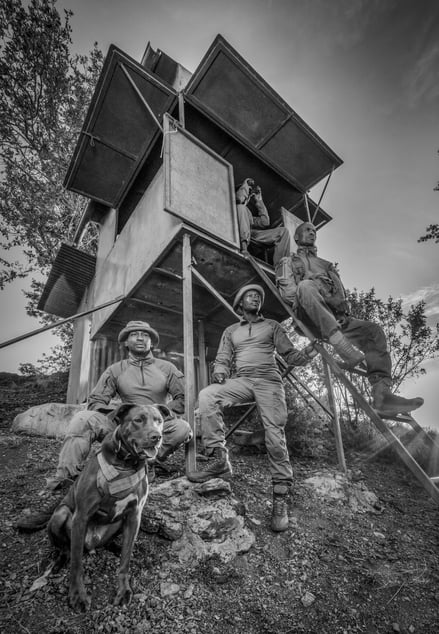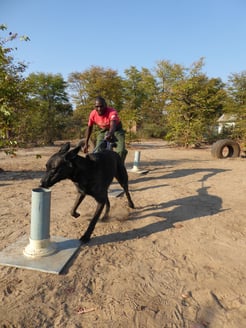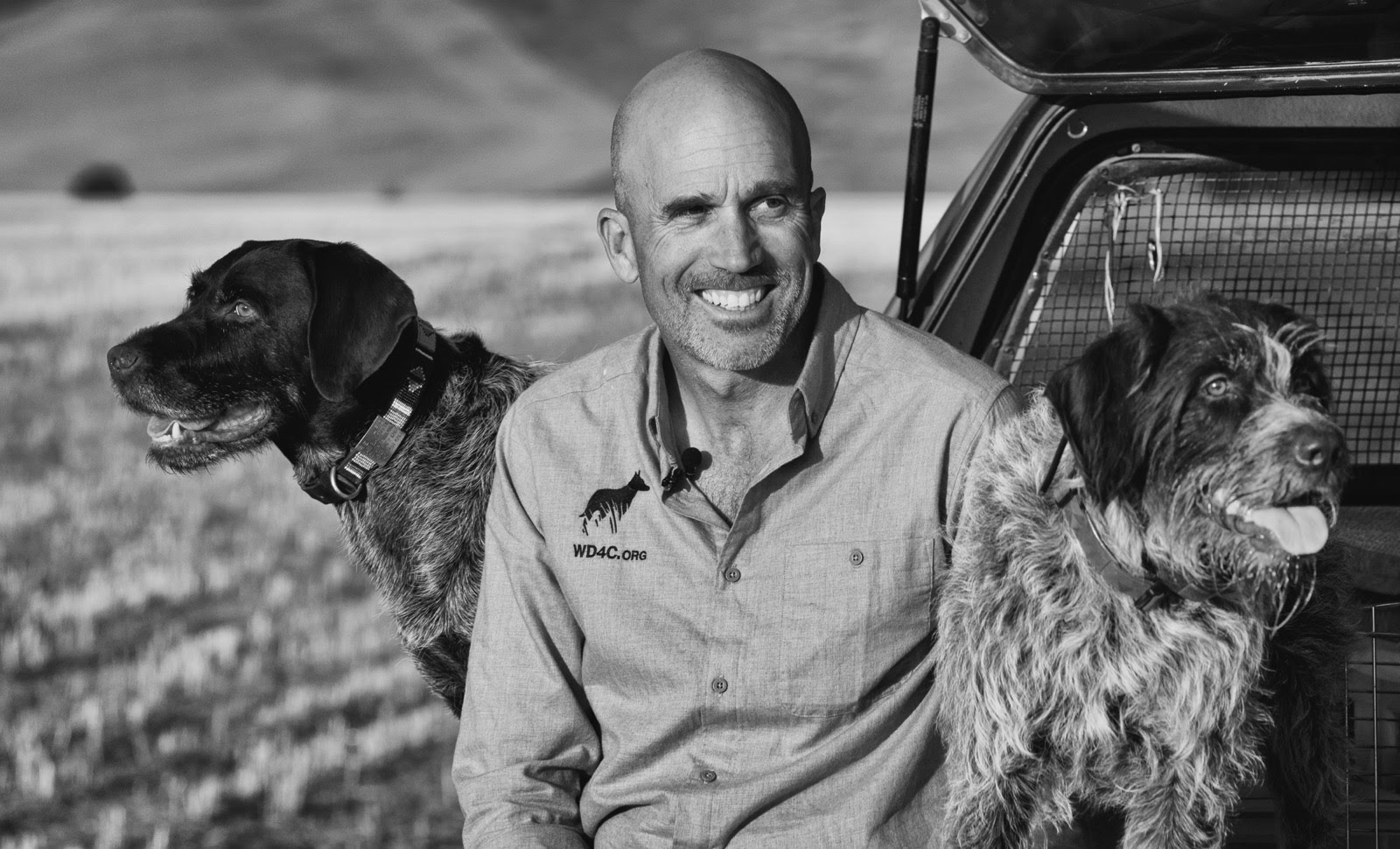A Practical Activist with Paws: Meet Tygee, Working Dogs for Conservation
- Bluestone Staff
- May 3, 2021
Featured image: Here's Tygee (on the far left) with his buddies on the Delta Team, the Canine Law Enforcement Team from Conservation South Luangwa.
Tygee (pronounced TI-GEE) is a detection dog with Working Dogs for Conservation (WD4C). WD4C trains the world's best conservation detection dogs and puts them to work protecting wildlife and wild places. We’ll be “talking” to Tygee today and also the human in charge at WD4C, Executive Director, Pete Coppolillo (pronounced CO-PO-LIL-OH).
Q: Tygee, let’s start with a little bit about your background, and how you came to WD4C?
A: Early on, my first people didn’t really get me. My first owner liked how big and intimidating I looked as a 90-pound Dutch/German shepherd mix— but she wasn’t allowed to have me where she lived, and I didn’t get to work at all. This was really hard for somebody with as much energy and drive as I have. Then, I made the classic mistake of barking at a child, and I got labeled as “aggressive” and had to spend almost a month all by myself in a 4 foot by 4 foot kennel.
Finally, one of the shelter workers where I was staying in Virginia called WD4C and Megan Vick, who is a master trainer and a dog handler, came to get me. She’s an amazing human, a retired Navy veteran who used to work with dogs as a game warden. It took a long time for me to trust her, but she was patient and taught me so much, and now I trust everybody. There's a special bond between us and our humans. Here's a good video that you might like that explains it.
I’m also part of the second generation of dogs that have gone to work in Zambia and Tanzania. There are now 200 of us in Africa and we’re going to expand to Asia too.
Photo below: Tygee's buddy, Popo, and the Serengeti Canine Team (Operated by the Grumeti Fund) at an Observation Point in the Grumeti Game Reserve, part of the Serengeti Ecosystem. 
Q: What kinds of missions have you been on lately and do you have a favorite project that you’ve worked on that you’re particularly proud of?
A: I’m a law enforcement dog, which means I help stop wildlife crime. I live in Zambia, and I can recognize the scent of lots of different wildlife species here from pangolins and elephants (including their ivory) to leopards (including their skins). I inspect vehicles and buildings and sometimes even open fields where people might hide a tusk or something else illegal.
I’m most proud of how I detect firearms and ammunition. Most of the guns I encounter here in Zambia are illegal, so it’s great to find them BEFORE someone uses them to harm a wild animal. My people tell me that poachers share guns, so each time I find one, I put 7-10 poachers out of business. That’s pretty cool.
I like how I am part of it all: from catching poachers on the ground to sniffing vehicles and containers to prevent them from trafficking animal products.
Also, did I mention that Dr. Jane Goodall is a fan of our work too! Check out this video.
Q: Talk to me about your nose and how that empowers and informs your work at WD4C? It’s incredible what you can do.
Image below: Tygee and his handler, Sydney, are training using "snorkels" in which we can hide scents.
 A: My nose is pretty special— that’s one of the best things about being a dog—we are really gifted in that department. I can smell things at very low concentrations—parts per trillion. That’s like putting a teaspoon of sugar in the equivalent of two Olympic swimming pools of water, and then I can smell that it’s there. Oh, and it doesn’t matter if there’s other stuff mixed in there too— I can still smell the sugar.
A: My nose is pretty special— that’s one of the best things about being a dog—we are really gifted in that department. I can smell things at very low concentrations—parts per trillion. That’s like putting a teaspoon of sugar in the equivalent of two Olympic swimming pools of water, and then I can smell that it’s there. Oh, and it doesn’t matter if there’s other stuff mixed in there too— I can still smell the sugar.
And the best part of my nose is that it’s connected to me, and I’m very social, and I LOVE playing with my handler, so we’ve got this game going. I find the stuff that she tells me to look for, and then we play ball and tug of war and have a party. It’s almost not fair because it’s really easy for me. Humans work so hard and do silly things to make it harder— like wrapping ivory or bullets in plastic— but smell just comes right through that stuff, so I win the game a lot.
Q: Now, let’s shift to our human-in-charge, Pete Coppolillo. Tell us about how WD4C began and how your work has evolved.
Photo below: Executive Director, Pete Coppolillo.

A: We were founded by four women who were all biologists and dog-trainers, and they are still with us today. They wanted a better way to do conservation. In the mid-90s, it became possible to get DNA from scat. So, fecal DNA was a big deal in our origin story because with it, you could find out information about where species were going and what they were doing from their scat — without seeing them, scaring them or having to capture them which is very expensive and dangerous for people and wildlife. This was also around the time that the grizzly bear was just starting to recover in the lower 48 (U.S. states.) Knowing where grizzly bears go was important back then, because they were recolonizing areas they hadn’t been in decades or more, so those areas needed protection and people needed to take precautions to prevent conflict. The first grizzly bear project we did was in Canada where the dogs were able to find grizzly scats that we could take to the lab and confirm it was a grizzly. Now, it’s fast, it’s cheap and we can tell it’s a grizzly bear vs. a black bear, which sex, and which population it came from…which is important for us to know if or when a population is going to mix.
So, that’s an example of the ecological monitoring part of what we do: finding species and saving their habitats. Because our methods grew out of search and rescue, it was an easy pivot into wildlife crime and law enforcement, and that work coincided with the global outbreak of trafficking in wildlife and wildlife products. From 2007-2012, wildlife crime and trafficking increased as global trade grew in Asia and specifically with China. We knew it was critical to stop the carnage, so we dove into wildlife crime work.
There have been many advances. For example, it’s now possible suck air out of the shipping containers, pass it through a filter, and present the filters from many containers to a dog, and the dog will alert if there is ivory, rhino horn, or shark fin in the container, all without having to open it. It saves time and money and opens the door for much better enforcement.
Unfortunately, we’re going to be doing this work for a long time since illegal wildlife trafficking is generally either #3 or #4 on the list of illicit markets worldwide.
Our third service area, biosecurity and invasive species, is related because when you have commerce moving all over the world, there is biological material that moves with it. Initially, we started out just preventing it, stop the first plant or the first bug whether it’s an emerald ash or a spottled lantern fly. Then if it happens, we’re there to help manage it…draw a line around it and know where you have to do eradication or control work. Then, when you get to the end of the infestation, we can use the dogs to find every last invasive plant or species. For example, we did one on the Channel Islands of California finding Argentine ants. Our dog, Tobias found an ant colony that was left behind, and he prevented it from would have repopulating the island.
Q: Your academic education began in biology and environmental conservation and you also have Ph.D. in Ecology. What drew you to the field of conservation and what brought you to WD4C?
A: I grew up watching Jacques Cousteau, so I wanted to be a marine biologist, but a kid from Colorado was sensibly nudged toward more terrestrial pursuits. I got interested in herding people in Africa, and then when you combine biology with a “save-the-world” gene, you get conservation.
I trained as an ecologist because you can move sideways, and laterally and do all sorts of different things. The academic world drives us all to specialize, but I really believe that big ideas come from the lateral thinkers…the people who can take one idea from over here and one from over there. One of the gratifying things about conservation is the opportunity to be nimble and work on a wide range of things, I’ve worked on water and rivers and rice cultivation in Africa to diseases and how caviar is made…I’ve become less specialized and I love that and the perspective it brings.
As for the dogs, I got excited about them and the possibilities they provide, so I started collaborating with them in my role as a “mainstream” conservationist, which led the way to me joining the WD4C Board. And then in 2012, the Board said to the founders, “you need somebody to chase money and direct traffic.” So, I said, “I’ll do it.”
Q: You’ve traveled all over the world doing conservation work, is there any work that was transformative for you in your life journey?
Africa has been transformative for me and I know for many people…from the wildlife, the landscapes, the history, adventure, the access…all of it. While working in Africa can be really hard for some folks, it can also be amazing for others. You can have an enormous impact, which is kind of addictive. Things can also be unpredictable and move very slowly there, so learning to be prepared and have a long time horizon are both key.
Q: Two Bluestone customers, Dan and Bri Bushkin, chose Working Dogs for Conservation for their Impact Rider which is included in Bluestone's Premiums with Purpose. This becomes a potential new source of funding for the future. How do you see nonprofit fundraising and philanthropy changing in the future?
A: We were thrilled and humbled to learn that your customers chose us. I’ll be honest: I had no idea that people could do that, but it makes perfect sense. I sit on two Boards and I contribute my time and money as well, so including them in my life insurance made perfect sense, even though I hadn’t done it.
Planned giving is an enormous help for us. In the early years, we were worried about paying the bills and keeping the doors open, and now we’re asking how we can fund work on high-priority, but less well known species. Planned giving helps us look 5, 10, 20 years down the road, so we know we’re going to be doing this work and making a difference. The role that life insurance like yours can play is a huge one. We see bequests and planned giving as one of the key things that is allowing us to move from being an organization to an institution.
Q: Do you have any advice for people who want to get involved in conservation? Where to begin?
A: Get out and do it. It’s really great that the world values experience now— back when I was a grad student we had to explain away “gaps” in our academic record, and now we value those gaps. Train a dog, do field research, volunteer on a fence-modification project…whatever speaks to you just get in the game. And I’m also happy that more and more organizations including ours, are making those volunteer opportunities and internships more accessible by providing stipends and financial support, so the opportunities are not just available to wealthier kids whose parents can bankroll an internship.
Q: What are you reflecting on as you look to the future?
A: What I learned from this pandemic is that you don’t get your house in order when a crisis happens. You need to be on solid ground before it hits. As an organization, we made this transition from a scarcity mindset to more of an abundance mindset. We’re doing great things and those things are going to bring more great things…we now think of ourselves as an institution that can not only weather the storm, but can come out better on the other side.
I also look forward to more work in the environmental justice arena. Doing more work in partnership with Native nations, providing those communities more access and exposure to work in conservation…that’s a win-win for their communities and for advancing ecological work.
Q: Do you have a mantra or quote that you live by or that inspires you?
A: Watching a dog work inspires me. It inspires almost anyone who does. I’m envious at the way dogs can completely lose themselves in the world around them and to be so fulfilled and gratified by their work, so if I had to turn that into a mantra, I’d say it’s, “Work like a dog… and love it like a dog!”
Q: Let’s leave the last word to Tygee any final thoughts?
A: It’s good to see people catching on to our unique abilities as dogs. You guys are just scratching the surface, and I can’t wait to show you all the things we’re capable of. You keep asking us to do crazier and harder stuff and we keep doing it…and making the world better and safer in the process. I know there are scientists and engineers trying to copy what my nose can do, and to them I say: here’s millions of years of sensory evolution with a wagging tail and a lot of love. You can’t replicate that!
A life insurance policy from Bluestone Life can benefit nonprofits like Working Dogs for Conservation. One percent of Bluestone’s revenue and a complimentary Impact Rider can be part of the solution for environmental conservation. We encourage the Practical Activist in all of us to get involved and support organizations like Working Dogs for Conservation.
Like hearing about Practical Activists?
We’ll share their stories with you monthly. (No email overload… we promise!)


